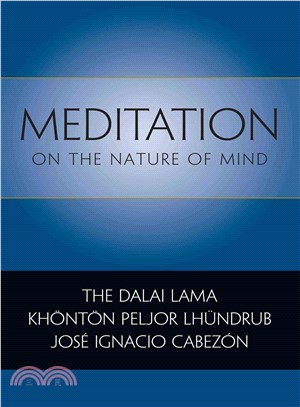Meditation on the Nature of Mind
商品資訊
ISBN13:9780861716289
出版社:Wisdom Pubns
作者:Dalai Lama XIV; Khonton Peljor Lhundrub; Jose Ignacio Cabezon
出版日:2011/05/17
裝訂/頁數:平裝/200頁
規格:23.5cm*15.9cm*1.9cm (高/寬/厚)
商品簡介
作者簡介
相關商品
商品簡介
A correct understanding of the mind’s nature not only illuminates the many treatises on Buddhist philosophy, it is the key to success in meditation and to the profound insights at the heart of the Buddha’s path.
The text at the center of this book, the Wish-Fulfilling Jewel of the Oral Tradition by Khöntön Peljor Lhündrub (15611637), manages to combine both theory and practical instructions for meditating on the nature of mind in a manner that is easily accessible. Especially interesting is its nonsectarian approach, with liberal citations from across the Tibetan Buddhist spectrum. His Holinesss the Dalai Lama’s broad-ranging overview of this important text in the first part of this book insightfully distills some of the most central themes of Buddhism: why the mind is so essential to the tradition, how science and Buddhism can benefit from mutual interaction, what distinguishes subtle and grosser levels of consciousness, how the different schools of Tibetan Buddhism elaborate such a distinction, and how all of these schools have a common source in the scholarly tradition of Nalanda Monastery, the greatest Buddhist university of ancient India. It is a profound and erudite teaching, both in scope and detail, and brings the reader closer to a fresh and direct experience of the all-important topic.
As little has been written in Western languages about Khöntön Rinpoché, this volume also includes a short biography of this interesting figure, who was a guru to the Great Fifth Dalai Lama.
The text at the center of this book, the Wish-Fulfilling Jewel of the Oral Tradition by Khöntön Peljor Lhündrub (15611637), manages to combine both theory and practical instructions for meditating on the nature of mind in a manner that is easily accessible. Especially interesting is its nonsectarian approach, with liberal citations from across the Tibetan Buddhist spectrum. His Holinesss the Dalai Lama’s broad-ranging overview of this important text in the first part of this book insightfully distills some of the most central themes of Buddhism: why the mind is so essential to the tradition, how science and Buddhism can benefit from mutual interaction, what distinguishes subtle and grosser levels of consciousness, how the different schools of Tibetan Buddhism elaborate such a distinction, and how all of these schools have a common source in the scholarly tradition of Nalanda Monastery, the greatest Buddhist university of ancient India. It is a profound and erudite teaching, both in scope and detail, and brings the reader closer to a fresh and direct experience of the all-important topic.
As little has been written in Western languages about Khöntön Rinpoché, this volume also includes a short biography of this interesting figure, who was a guru to the Great Fifth Dalai Lama.
作者簡介
Tenzin Gyatso, the Fourteenth Dalai Lama, is the spiritual leader of the Tibetan people. He frequently describes himself as a simple Buddhist monk. Born in northeastern Tibet in 1935, he was as a toddler recognized as the incarnation of the Thirteenth Dalai Lama and brought to Tibet's capital, Lhasa. In 1950, Mao Zedong's Communist forces made their first incursions into eastern Tibet, shortly after which the young Dalai Lama assumed the political leadership of his country. He passed his scholastic examinations with honors at the Great Prayer Festival in Lhasa in 1959, the same year Chinese forces occupied the city, forcing His Holiness to escape to India. There he set up the Tibetan government-in-exile in Dharamsala, working to secure the welfare of the more than 100,000 Tibetan exiles and prevent the destruction of Tibetan culture. In his capacity as a spiritual and political leader, he has traveled to more than sixty-two countries on six continents and met with presidents, popes, and leading scientists to foster dialogue and create a better world. In recognition of his tireless work for the nonviolent liberation of Tibet, the Dalai Lama was awarded the Nobel Peace Prize in 1989. In 2012, he relinquished political authority in his exile government and turned it over to democratically elected representatives.
His Holiness frequently states that his life is guided by three major commitments: the promotion of basic human values or secular ethics in the interest of human happiness, the fostering of interreligious harmony, and securing the welfare of the Tibetan people, focusing on the survival of their identity, culture, and religion. As a superior scholar trained in the classical texts of the Nalanda tradition of Indian Buddhism, he is able to distill the central tenets of Buddhist philosophy in clear and inspiring language, his gift for pedagogy imbued with his infectious joy. Connecting scientists with Buddhist scholars, he helps unite contemplative and modern modes of investigation, bringing ancient tools and insights to bear on the acute problems facing the contemporary world. His efforts to foster dialogue among leaders of the world's faiths envision a future where people of different beliefs can share the planet in harmony. Wisdom Publications is proud to be the premier publisher of the Dalai Lama's more serious and in-depth works.
Khonton Peljor Lhundrub was born in 1561 into the famous Khon clan, an ancient Tibetan family whose members include the founders and present-day throne holders of the Sakya school. His father, Tsewang Norgye, was an important figure in the transmission lineage of the Magical Net Tantra, one of the most important tantric systems of the Nyingma school. Khonton Rinpoche himself came to be considered one of the major figures in the transmission of this tantra. Khontonpa also played an important role in the history of the Gelug school. He was the fifteenth abbot of the Je College of Sera, and he came to be considered one of the lineage masters in the Gelug school's transmission of the "stages of the path" or lamrim teachings. Both the Nyingma and Gelug schools eventually came to consider him a reincarnation of the great Nyingma scholar-saint Dropugpa.
Jose Ignacio Cabezon is XIVth Dalai Lama Professor of Tibetan Buddhism and Cultural Studies at the University of California Santa Barbara. He studied physics as an undergraduate at Caltech, trained as a monk at Sera Monastery in India, translated for the Dalai Lama into Spanish, and in 1987 earned his PhD from the University of Wisconsin-Madison. Before coming to Santa Barbara, he was on the faculty of the Iliff School of Theology in Denver from 1989-2001. Cabezon is the author or editor of a dozen books and many more articles on various aspects of Tibetan religion and religious studies, with research interests as diverse as Madhyamaka philosophy, Buddhism and sex, and Tibetan ritual. His latest publication, the Sera Project, is
His Holiness frequently states that his life is guided by three major commitments: the promotion of basic human values or secular ethics in the interest of human happiness, the fostering of interreligious harmony, and securing the welfare of the Tibetan people, focusing on the survival of their identity, culture, and religion. As a superior scholar trained in the classical texts of the Nalanda tradition of Indian Buddhism, he is able to distill the central tenets of Buddhist philosophy in clear and inspiring language, his gift for pedagogy imbued with his infectious joy. Connecting scientists with Buddhist scholars, he helps unite contemplative and modern modes of investigation, bringing ancient tools and insights to bear on the acute problems facing the contemporary world. His efforts to foster dialogue among leaders of the world's faiths envision a future where people of different beliefs can share the planet in harmony. Wisdom Publications is proud to be the premier publisher of the Dalai Lama's more serious and in-depth works.
Khonton Peljor Lhundrub was born in 1561 into the famous Khon clan, an ancient Tibetan family whose members include the founders and present-day throne holders of the Sakya school. His father, Tsewang Norgye, was an important figure in the transmission lineage of the Magical Net Tantra, one of the most important tantric systems of the Nyingma school. Khonton Rinpoche himself came to be considered one of the major figures in the transmission of this tantra. Khontonpa also played an important role in the history of the Gelug school. He was the fifteenth abbot of the Je College of Sera, and he came to be considered one of the lineage masters in the Gelug school's transmission of the "stages of the path" or lamrim teachings. Both the Nyingma and Gelug schools eventually came to consider him a reincarnation of the great Nyingma scholar-saint Dropugpa.
Jose Ignacio Cabezon is XIVth Dalai Lama Professor of Tibetan Buddhism and Cultural Studies at the University of California Santa Barbara. He studied physics as an undergraduate at Caltech, trained as a monk at Sera Monastery in India, translated for the Dalai Lama into Spanish, and in 1987 earned his PhD from the University of Wisconsin-Madison. Before coming to Santa Barbara, he was on the faculty of the Iliff School of Theology in Denver from 1989-2001. Cabezon is the author or editor of a dozen books and many more articles on various aspects of Tibetan religion and religious studies, with research interests as diverse as Madhyamaka philosophy, Buddhism and sex, and Tibetan ritual. His latest publication, the Sera Project, is
主題書展
更多
主題書展
更多書展今日66折
您曾經瀏覽過的商品
購物須知
外文書商品之書封,為出版社提供之樣本。實際出貨商品,以出版社所提供之現有版本為主。部份書籍,因出版社供應狀況特殊,匯率將依實際狀況做調整。
無庫存之商品,在您完成訂單程序之後,將以空運的方式為你下單調貨。為了縮短等待的時間,建議您將外文書與其他商品分開下單,以獲得最快的取貨速度,平均調貨時間為1~2個月。
為了保護您的權益,「三民網路書店」提供會員七日商品鑑賞期(收到商品為起始日)。
若要辦理退貨,請在商品鑑賞期內寄回,且商品必須是全新狀態與完整包裝(商品、附件、發票、隨貨贈品等)否則恕不接受退貨。
























